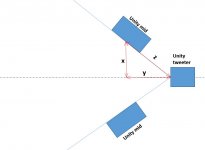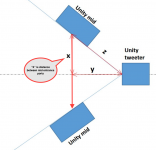Giri,
With digital time alignment, the "Y" axis can be corrected to exactly the same arrival time regardless of it's distance.
Ideally, the center to center distance between the ports, double the distance of your "X", and the "Z" distance both should be within 1/4 wavelength for the best polar response.
As the distance is increased past 1/4 wavelength, off axis polar response will suffer.
That said, when using conical horn expansions, off axis polar response is never quite ideal.
Art
With digital time alignment, the "Y" axis can be corrected to exactly the same arrival time regardless of it's distance.
Ideally, the center to center distance between the ports, double the distance of your "X", and the "Z" distance both should be within 1/4 wavelength for the best polar response.
As the distance is increased past 1/4 wavelength, off axis polar response will suffer.
That said, when using conical horn expansions, off axis polar response is never quite ideal.
Art
Attachments
Along Y there is a deep cancellation notch, due to reflection off the throat (CD diaphragm) so the 1/4 WL rule applies to Y as well.
Try to keep both X and Z within 1/4 wave...if possible.
A lot of theory goes on trying to be precise, but in the end common sense says the closer the acoustic centers, the better.
Good ole phase wheel, ya know...
A lot of theory goes on trying to be precise, but in the end common sense says the closer the acoustic centers, the better.
Good ole phase wheel, ya know...
Giri,
With digital time alignment, the "Y" axis can be corrected to exactly the same arrival time regardless of it's distance.
Ideally, the center to center distance between the ports, double the distance of your "X", and the "Z" distance both should be within 1/4 wavelength for the best polar response.
As the distance is increased past 1/4 wavelength, off axis polar response will suffer.
That said, when using conical horn expansions, off axis polar response is never quite ideal.
Art
I thought over your 2X distance constraint. I wonder if Danley's own products would confirm to that constraint.
You will need lesser distance than the theoretical calculation. There is a null due to the distance(reflection from CD) and to design an xover you need the null to be higher than your crossover point hence some margin will be needed.
That depends on the shape of the roll off on the drivers in question. My mids can be crossed over with a 4th order slope on the lowpass using most of the slope of the null to do it. If I wanted to do the same on its highpass I would have to use a 6th order slope.
Rob.
Rob.
- Home
- Loudspeakers
- Multi-Way
- Unity/Synergy horn tweeter-mid distance constraint

